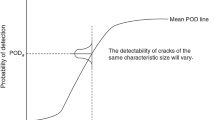Abstract
This paper outlines a proposed methodology for using combinations of physical modeling of an inspection process along with laboratory and production data to estimate Nondestructive Evaluation (NDE) capability. The physical/statistical prediction model will be used to predict Probability of Detection (POD), Probability of False Alarm (PFA) and Receiver Operating Characteristic (ROC) function curves. These output functions are used to quantify the NDE capability. The particular focus of this work is on the use of ultrasonic methods for detecting hard-alpha and other subsurface flaws in titanium using gated peak detection. This is a uniquely challenging problem since the inspection must detect very complex subsurface flaws with significant “material” noise. However, the underlying framework of the methodology should be general enough to apply to other NDE methods.
Access this chapter
Tax calculation will be finalised at checkout
Purchases are for personal use only
Preview
Unable to display preview. Download preview PDF.
Similar content being viewed by others
References
Margetan, F. J., Yalda, I. and Thompson, R. B. (1995), Predicting Gated-Peak Grain Noise Distributions for Ultrasonic Inspections at Metals. This proceedings.
Thompson, R.B., and Gray, T.A., (1986), Use of ultrasonic models on the design and validation of new NDE techniques, Phil. Trans. R. Soc. London A., Vol. 320, pp. 329–340, 1986.
Thompson, R.B., and Gray, T.A., (1983), A model relating ultrasonic scattering measurements through liquid-solid interfaces to unbounded medium scattering amplitudes, J. Acoust. Soc. Am., Vol. 74, pp. 1279–1290.
Chiou, C.P., Margetan, F.J., and Thompson, R.B. (1995), Ultrasonic signal characterizations of flat-bottom holes in titanium alloys: experiment and theory, Review of Progress in Quantitative NDE, 14B, D.O. Thompson and D.E. Chimenti, Eds. (Plenum Press, NY, 1995), 2121–2128.
Author information
Authors and Affiliations
Editor information
Editors and Affiliations
Rights and permissions
Copyright information
© 1996 Plenum Press, New York
About this chapter
Cite this chapter
Meeker, W.Q., Thompson, R.B., Chiou, CP., Jeng, SL., Tucker, W.T. (1996). Methodology for Estimating Nondestructive Evaluation Capability. In: Thompson, D.O., Chimenti, D.E. (eds) Review of Progress in Quantitative Nondestructive Evaluation. Springer, Boston, MA. https://doi.org/10.1007/978-1-4613-0383-1_260
Download citation
DOI: https://doi.org/10.1007/978-1-4613-0383-1_260
Publisher Name: Springer, Boston, MA
Print ISBN: 978-1-4613-8027-6
Online ISBN: 978-1-4613-0383-1
eBook Packages: Springer Book Archive




